Experimental Study on the Salt Freezing Durability of Multi-Walled Carbon Nanotube Ultra-High-Performance Concrete
Abstract
:1. Introduction
2. Materials and Methods
2.1. Sample Preparation
2.2. Test Apparatus
2.3. Experiment Program
3. Results and Discussion
3.1. Optimal Mix Proportion Based on Mechanical Properties in a Non-Salt Freezing Environment
3.2. Rapid FT Test
3.2.1. Morphological and Compressive Strength
3.2.2. Mass Loss Rate
3.2.3. Relative Dynamic Modulus of Elasticity
3.3. Microscopic Analysis
3.3.1. Scanning Electron Microscope Observation
3.3.2. Nuclear Magnetic Resonance Test
4. Conclusions
- The addition of carbon nanotubes significantly improved the compressive strength and flexural strength of concrete. With the increase in the MWCNTs content, the variation curves of the compressive strength and flexural strength of the specimens increased at first and then decreased. Considering the cost factor, the optimum mix proportion was found to be a 0.19 water binder ratio and 0.1% carbon nanotube content. At this time, the compressive strength of the specimen was 122.7 MPa and the flexural strength was 9.2 MPa. The strength was increased by 34.1% and 13.6%, respectively, compared with the control group with an MWCNTs content of 0.
- The MWCNTs UHPC prepared based on the optimal mix proportion showed good frost resistance and salt erosion resistance under the combined action of salt erosion and low temperatures. After 1500 salt freezing cycles, the appearance and mass loss of concrete did not change, and the maximum quality loss was 3.18%. The more complex the salt composition and the greater the mass fraction of the erosion solution, the higher the loss rate of compressive strength, up to 40%. This reduces RDME to 91.3%.
- After 1500 salt freezing cycles, the microstructure of concrete was still dense. The salt freezing cycle has a significant influence on the change in the small pores but has little influence on the change in the medium pores and large pores. The larger the mass fraction of the erosion solution, the smaller the change in the pore proportion.
Author Contributions
Funding
Institutional Review Board Statement
Informed Consent Statement
Data Availability Statement
Acknowledgments
Conflicts of Interest
References
- Wang, B.X.; Pan, J.J.; Fang, R.C.; Wang, Q. Damage model of concrete subjected to coupling chemical attacks and freeze-thaw cycles in saline soil area. Constr. Build. Mater. 2020, 242, 118205. [Google Scholar] [CrossRef]
- Paual, B.; Hooton, R.D.; Boyd, C. Microstructual changes in concretes with sulfate exposure. Cem. Concr. Compos. 2004, 26, 993–999. [Google Scholar]
- Gastaldini, A.L.G.; Isaia, G.C.; Saciloto, A.P.; Missau, F.; Hoppe, T.F. Influence of curing time on the chloride penetration resistance of concrete containing rice husk ash: A technical and economic feasibility study. Cem. Concr. Compos. 2010, 32, 783–793. [Google Scholar] [CrossRef]
- Jan, D. Freezing and deicing salt resistance of blast furnace slag concretes. Cem. Concr. Compos. 2003, 25, 357–361. [Google Scholar]
- Sahmaran, M.; Erdem, T.K.; Yarnan, L.O. Sulfate resistance of plain and blended cements exposed to wetting-drying and heating-cooling environments. Constr. Build. Mater. 2007, 21, 1771–1778. [Google Scholar] [CrossRef]
- Ji, Y.; Liu, W.; Jia, Y.; Li, W. Durability Investigation of Carbon Fiber Reinforced Concrete under Salt-Freeze Coupling Effect. Materials 2021, 14, 6856. [Google Scholar] [CrossRef]
- Shi, C.J.; Wu, Z.M.; Xiao, J.F.; Wang, D.H.; Huang, Z.Y.; Fang, Z. A review on ultra-high performance concrete: Part I. Raw materials and mixture design. Constr. Build. Mater. 2015, 101, 741–751. [Google Scholar] [CrossRef]
- Zhou, M.; Lu, W.; Song, J.W.; Lee, G.C. Application of Ultra-High Performance Concrete in bridge engineering. Constr. Build. Mater. 2018, 186, 1256–1267. [Google Scholar] [CrossRef]
- Dong, Y. Performance Assessment and Design of Ultra-High Performance Concrete (UHPC) Structures Incorporating Life-Cycle Cost and Environmental Impacts. Constr. Build. Mater. 2018, 167, 414–425. [Google Scholar] [CrossRef]
- Marvila, M.T.; Azevedo, A.R.G.; Matos, P.R.; Monteiro, S.N.; Vieira, C.M.F. Materials for Production of High and Ultra-High Performance Concrete: Review and Perspective of Possible Novel Materials. Materials 2021, 14, 4304. [Google Scholar] [CrossRef]
- Iijima, S. Helical microtubules of graphitic carbon. Nature 1991, 354, 56–58. [Google Scholar] [CrossRef]
- Yu, M.F.; Lourie, O.; Dyer, M.J.; Moloni, K.; Kelly, T.F.; Ruoff, R.S. Strength and breaking mechanism of multiwalled carbon nanotubes under tensile load. Science 2000, 287, 637–640. [Google Scholar] [CrossRef] [PubMed] [Green Version]
- Huang, J.Y.; Chen, S.; Wang, Z.Q.; Kempa, K.; Wang, Y.M.; Jo, S.H.; Chen, G.; Dresselhaus, M.S.; Ren, Z.F. Superplastic carbon nanotubes. Nature 2006, 439, 281. [Google Scholar] [CrossRef] [PubMed]
- Han, B.; Sun, S.; Ding, S.; Zhang, L.; Yu, X.; Ou, J. Review of nanocarbon-engineered multifunctional cementitious composites. Compos. Part A Appl. Sci. Manuf. 2015, 70, 69–81. [Google Scholar] [CrossRef]
- Liew, K.M.; Kai, M.F.; Zhang, L.W. Carbon nanotube reinforced cementitious composites: An overview. Compos. Part A Appl. Sci. Manuf. 2016, 91, 301–323. [Google Scholar] [CrossRef]
- Kim, H. Chloride penetration monitoring in reinforced concrete structure using carbon nanotube/cement composite. Constr. Build. Mater. 2015, 96, 29–36. [Google Scholar] [CrossRef]
- Wang, J.; Bai, X.S.; Zhao, J.Y.; Gao, Z.Y. Carbon nanotubes enhance RPC bending fatigue performance. J. Build. Mater. 2020, 23, 1345–1349. [Google Scholar]
- Niu, X.J.; Peng, G.F.; He, J.; Lei, Z.H. Effect of multi-scale steel fiber combination and carbon nanotubes on mechanical properties of RPC. J. Build. Mater. 2020, 23, 216–223. [Google Scholar]
- Konsta-Gdoutos, M.S.; Metaxa, Z.S.; Shah, S.P. Highly dispersed carbon nanotube reinforced cement based materials. Cem. Concr. Res. 2016, 40, 1052–1059. [Google Scholar] [CrossRef]
- Morteza, M.S.; Mahdi, M.; Hassan, A. Effect of functionalized multi-walled carbon nanotubes on mechanical properties and durability of cement mortars. J. Build. Mater. 2021, 41, 102407. [Google Scholar]
- Wang, B.M.; Han, Y.; Liu, S. Effect of highly dispersed carbon nanotubes on the flexural toughness of cement-based composites. Constr. Build. Mater. 2013, 46, 8–12. [Google Scholar] [CrossRef]
- Guan, X.C.; Bai, S.; Li, H.; Ou, J.P. Mechanical properties and microstructure of multi-walled carbon nanotube-reinforced cementitious composites under the early-age freezing conditions. Constr. Build. Mater. 2020, 223, 117–317. [Google Scholar] [CrossRef]
- Zhang, D.; Lu, F.L.; Liang, Y.J. Effect of carbon nanotubes on mechanical properties and durability of cement. Concrete 2019, 11, 10–14. [Google Scholar]
- Fakhim, B.; Hassani, A.; Rashidi, A. Preparation and microstructural properties study on cement composites reinforced with multi-walled carbon nanotubes. J. Compos. Mater. 2015, 49, 85–98. [Google Scholar] [CrossRef]
- GB175-2007; General Portland Cement. Chinese National Standards: Beijing, China, 2007.
- Liu, G.F.; Zhu, D.; Chen, Z.F.; Zhang, H.D. Experimental study on mechanical properties of carbon nanotube activated powder concrete. China Concr. Cem. Prod. 2021, 8, 5–9. [Google Scholar]
- Zhu, D. Experimental Study on Mechanical Properties and Sulfate Resistance of Carbon Nanotube Ultra-High Performance Concrete. Master’s Thesis, Changzhou University, Changzhou, China, 2021. [Google Scholar]
- Sun, H.Y.; Su, X.P.; Wang, X.P. Study on salt frost resistance durability of ordinary concrete under different salt environments. J. Changchun Insti. Eng. 2016, 17, 10–15. [Google Scholar]
- GB/T 50081-2019; Standard for Test Methods of Physical and Mechanical Properties of Concrete. Chinese National Standards: Beijing, China, 2019.
- GB/T 50082-2009; Standard for Test Methods of Long-Term Performance and Durability of Ordinary Concrete. Chinese National Standards: Beijing, China, 2009.
- Chen, F.L.; Qiao, P.Z. Probabilistic damage modeling and service-life prediction of concrete under freeze-thaw action. Mater. Struct. 2015, 48, 2697–2711. [Google Scholar] [CrossRef]
- Zhou, S.L.; Wang, H.; Wang, Q.S.; Wang, W.S.; Zhang, W. Mechanical properties and freeze-thaw durability of low-sand Replacement rate pervious concrete. Highway Eng. 2022, 47, 135–141. [Google Scholar]
- Zhang, J. Study on the effect of fiber types on freeze-thaw splitting strength of asphalt concrete. Highway Eng. 2019, 44, 193–196. [Google Scholar]
- Liu, J.P.; Yang, P.; Yang, Z.H. Experimental study on deformation characteristics of chloride silty clay during freeze-thaw in an open system. Cold Reg. Sci. Technol. 2022, 197, 103518. [Google Scholar] [CrossRef]
- Liu, J.P.; Yang, P.; Yang, Z.H. Water and salt migration mechanisms of saturated chloride clay during freeze-thaw in an open system. Cold Reg. Sci. Technol. 2021, 186, 103277. [Google Scholar]
- Lu, L.; Ouyang, D.; Xu, W. Mechanical Properties and Durability of Ultra High Strength Concrete Incorporating Multi-Walled Carbon Nanotubes. Materials 2016, 9, 419. [Google Scholar] [CrossRef] [PubMed] [Green Version]
- Li, G.Y.; Wang, P.M.; Zhao, X. Mechanical behavior and microstructure of cement composites incorporating surface-treated multi-walled carbon nanotubes. Carbon 2005, 43, 1239–1245. [Google Scholar] [CrossRef]
- Cwirzen, A.; Habermehl-Cwirzen, K.; Penttala, V. Surface decoration of carbon nanotubes and mechanical properties of cement/carbon nanotube composites. Adv. Cem. Res. 2008, 20, 65–73. [Google Scholar] [CrossRef]
- Ju, Y.Z.; Shen, T.; Wang, D.H. Bonding behavior between reactive powder concrete and normal strength concrete. Constr. Build. Mater. 2020, 242, 118024. [Google Scholar] [CrossRef]
- Lu, Z.; Feng, Z.G.; Yao, D.D.; Ji, H.R.; Qin, W.J.; Yu, L.M. Analysis on Influencing Factors of workability and strength of ultra-high performance concrete. Mater. Rep. 2020, 34, 203–208. [Google Scholar]
- Olanike, A.O. Experimental investigation into the freeze-thaw resistance of concrete using recycled concrete aggregates and admixtures. Civ. Eng. Archit. 2014, 2, 176–180. [Google Scholar] [CrossRef]
- Jiang, W.; Shen, X.; Xia, J.; Mao, L.; Yang, J.; Liu, Q. A numerical study on chloride diffusion in freeze-thaw affected concrete. Constr. Build. Mater. 2018, 179, 553–565. [Google Scholar] [CrossRef]
- Lu, Z.; Feng, Z.G.; Yao, D.D.; Li, X.J.; Ji, H. Freeze-thaw resistance of Ultra-High performance concrete: Dependence on concrete composition. Constr. Build. Mater. 2021, 293, 123523. [Google Scholar] [CrossRef]
- Lee, M.G.; Wang, Y.C.; Chiu, C.T. A preliminary study of reactive powder concrete as a new repair material. Constr. Build. Mater. 2007, 21, 182–189. [Google Scholar] [CrossRef]
- Ji, Y.Y. Experiment on Durability of Reactive Powder Concrete in Marine Environment; Harbin Institute of Technology: Harbin, China, 2011. [Google Scholar]
- Li, Y.F.; Wang, X.B.; Wei, F.T.; Sun, J.; Ma, J.D. Experimental study on freeze-thaw resistance of ultra-high strength concrete with different mineral admixtures. China Sci. 2017, 12, 2632–2636. [Google Scholar]
- Zhen, Q.M.; He, B.; Li, C.; Jiang, Z.W. Research Progress on crack self-healing of ultra-high performance concrete. J. Chin. Ceram. Soc. 2021, 49, 2450–2461. [Google Scholar]
- Wang, C.L.; Zhong, S.R.; Gao, R.Q.; Qu, Y.Y.; Huang, Z.Q. Analysis on Influencing Factors of ultra-high performance concrete preparation. Sichuan Build. Mater. 2020, 46, 1–3. [Google Scholar]
- Metaxa, Z.S.; Konsta-Gdoutos, M.S.; Shah, S.P. Carbon nanotubes reinforced concrete. ACI Spec. Publ. 2009, 267, 11–20. [Google Scholar]
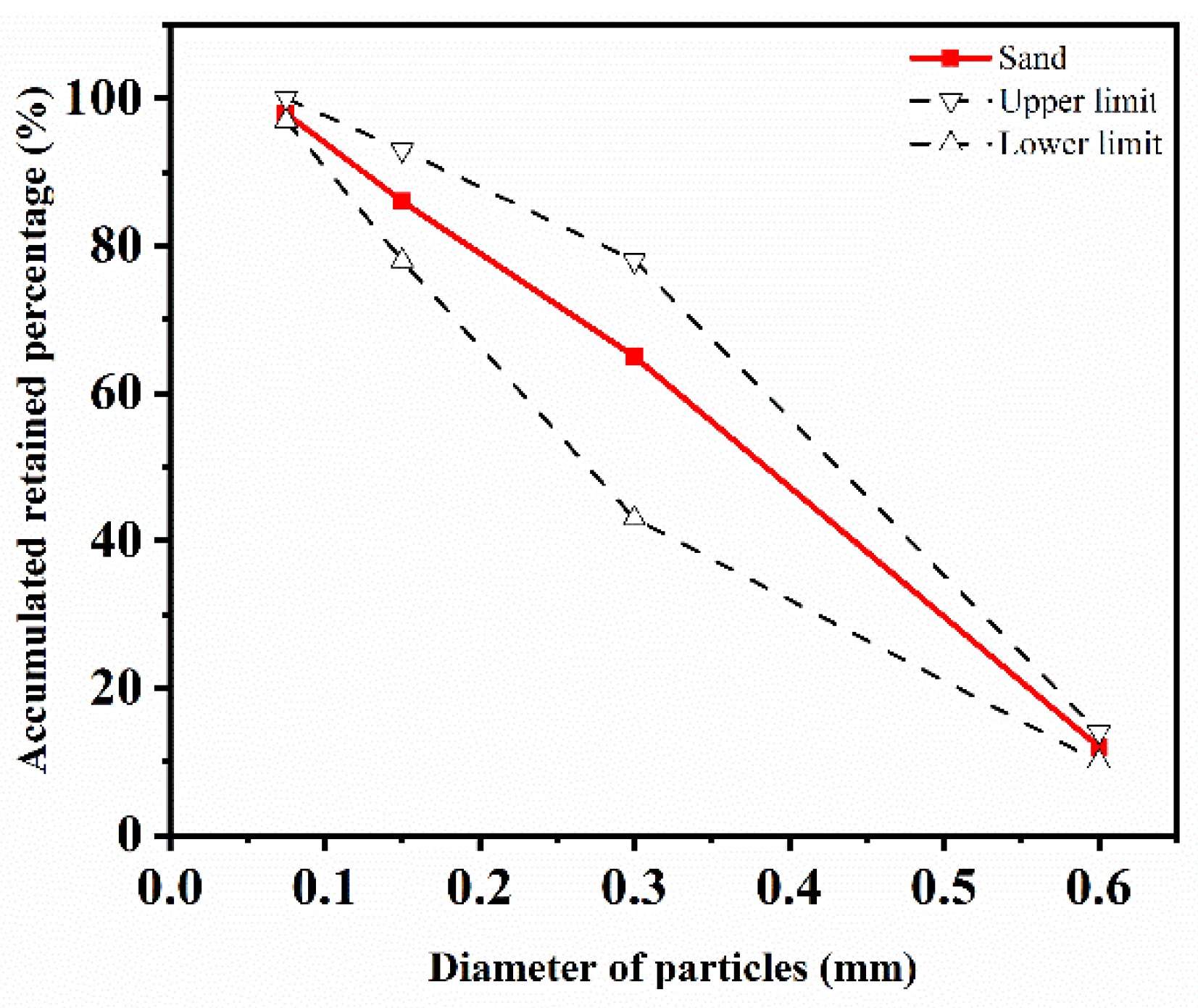


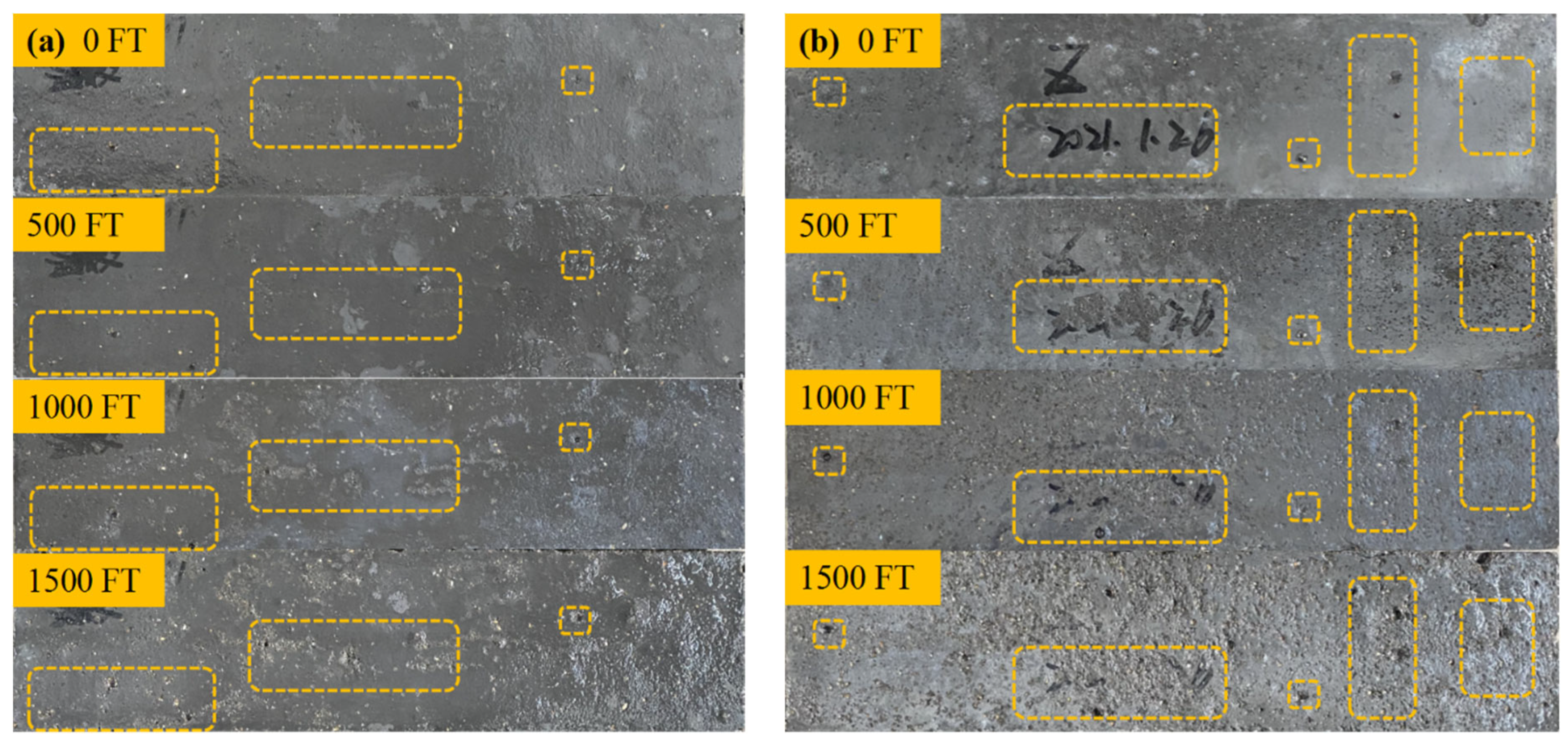
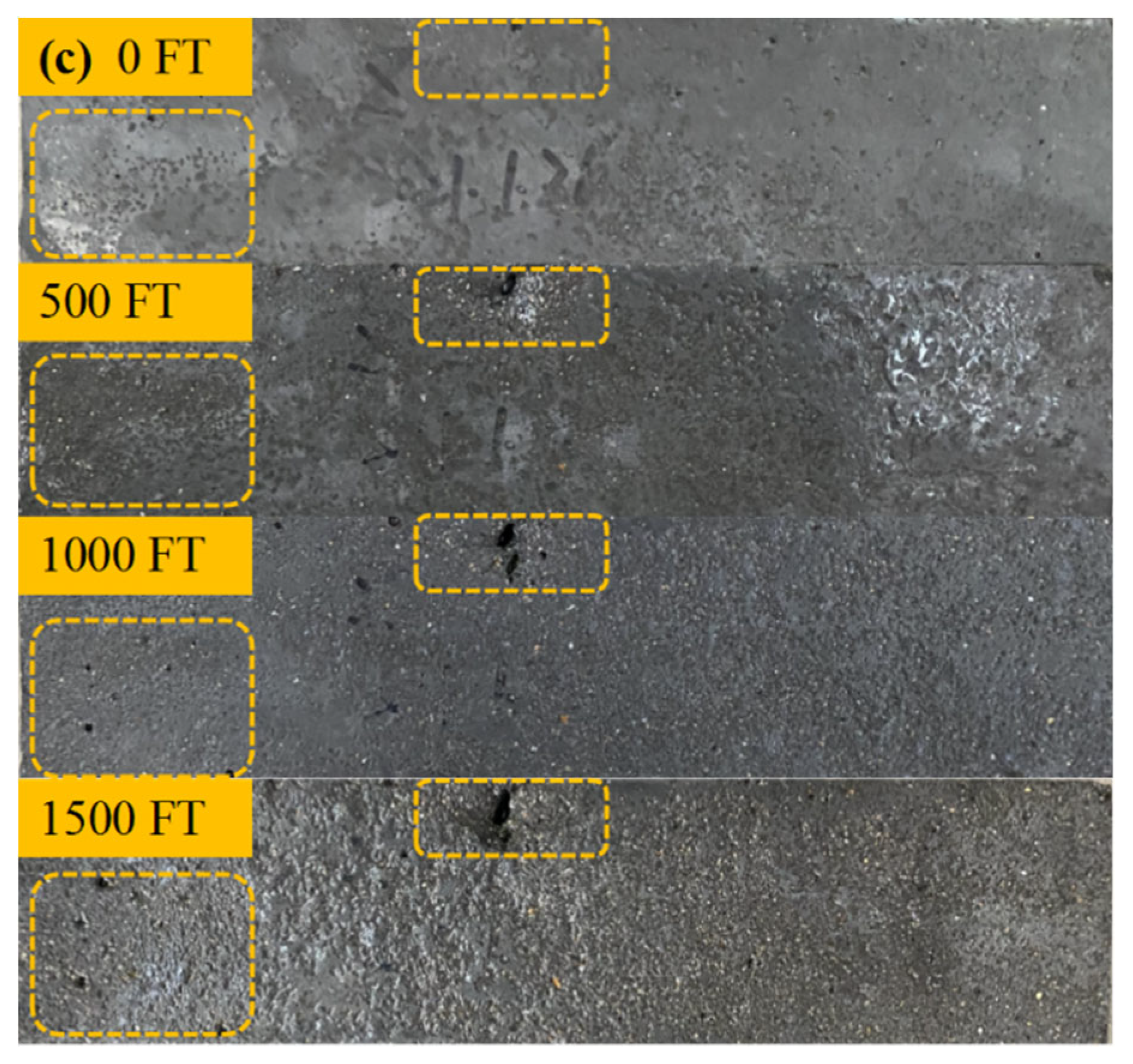


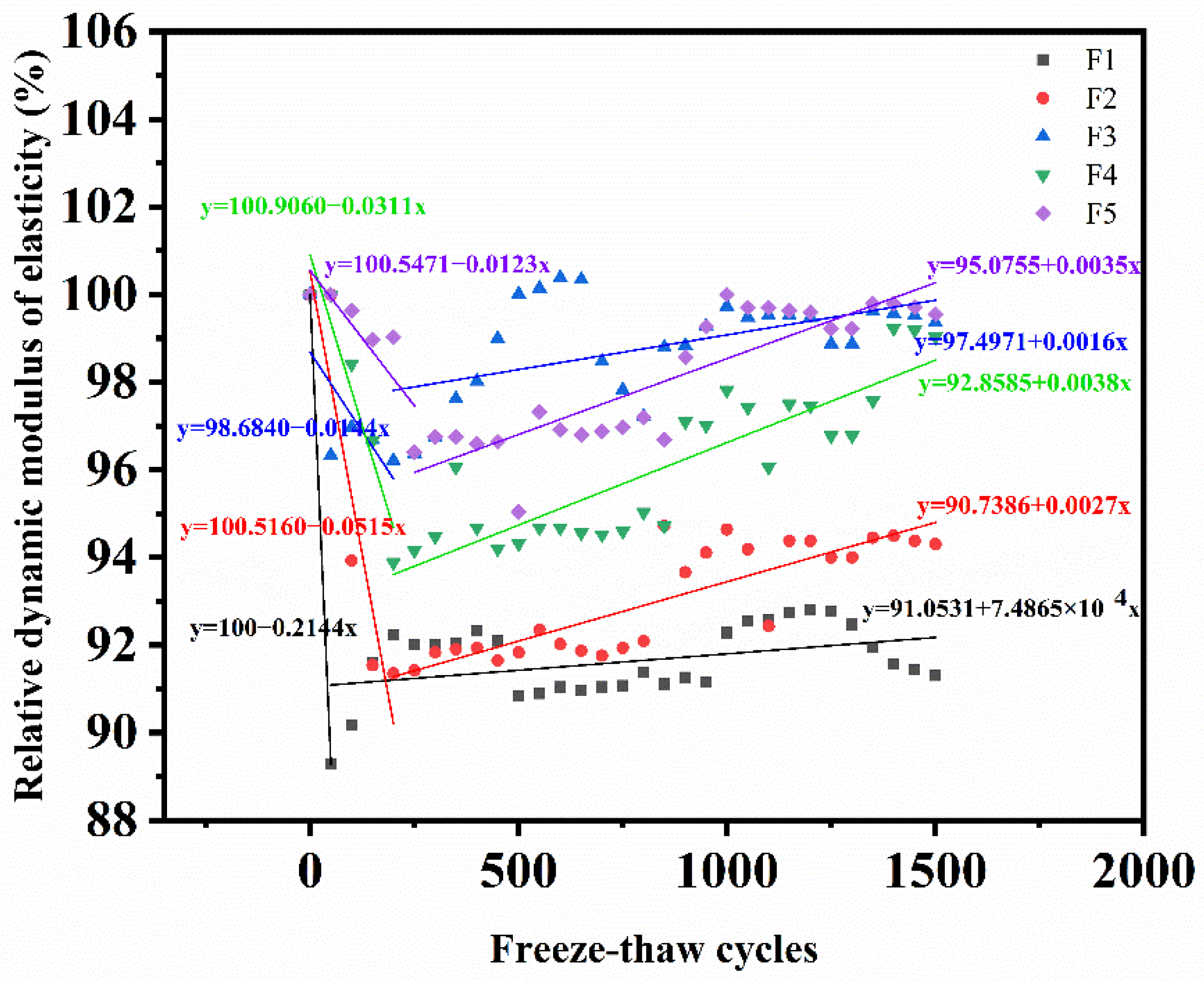
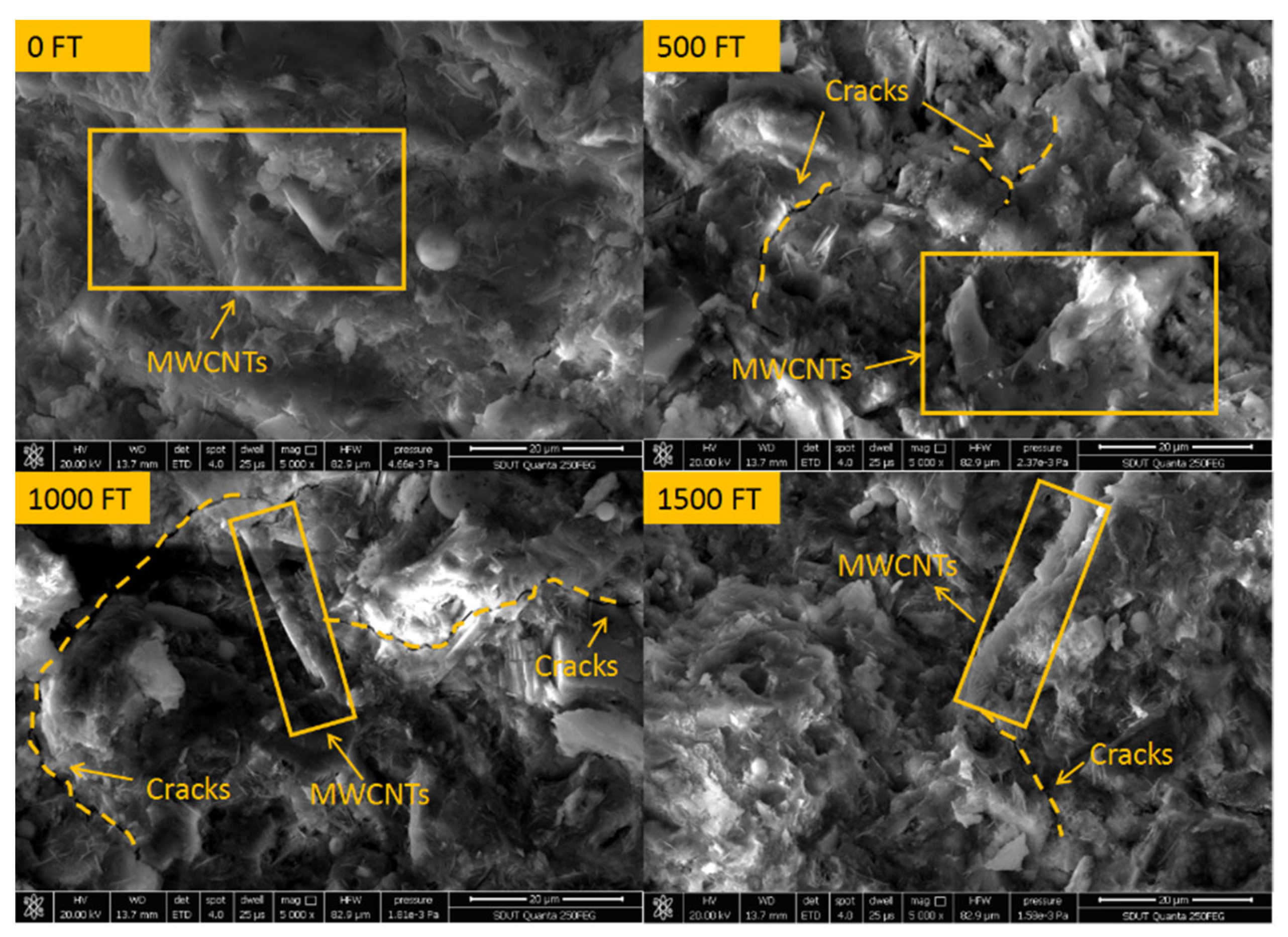
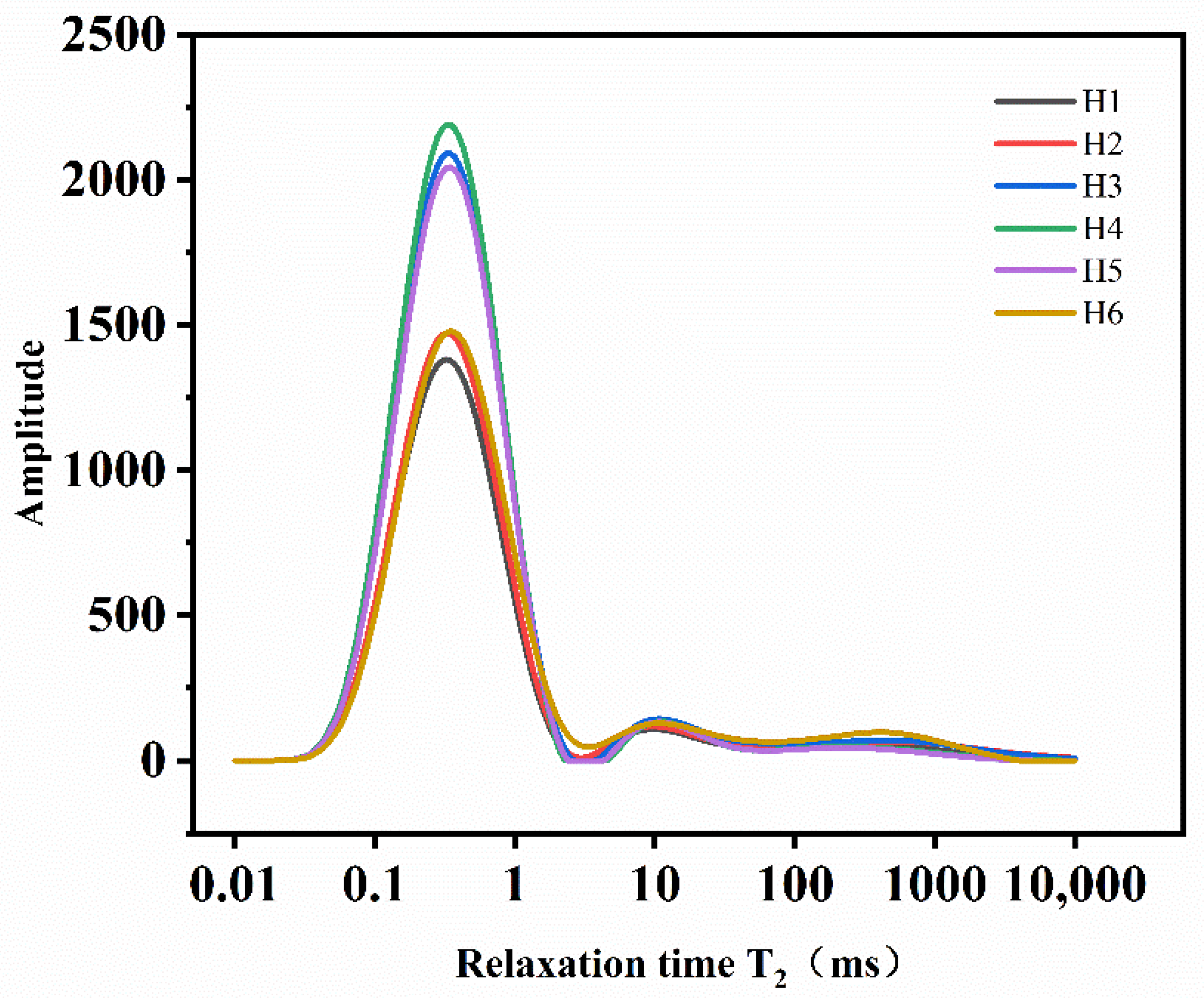
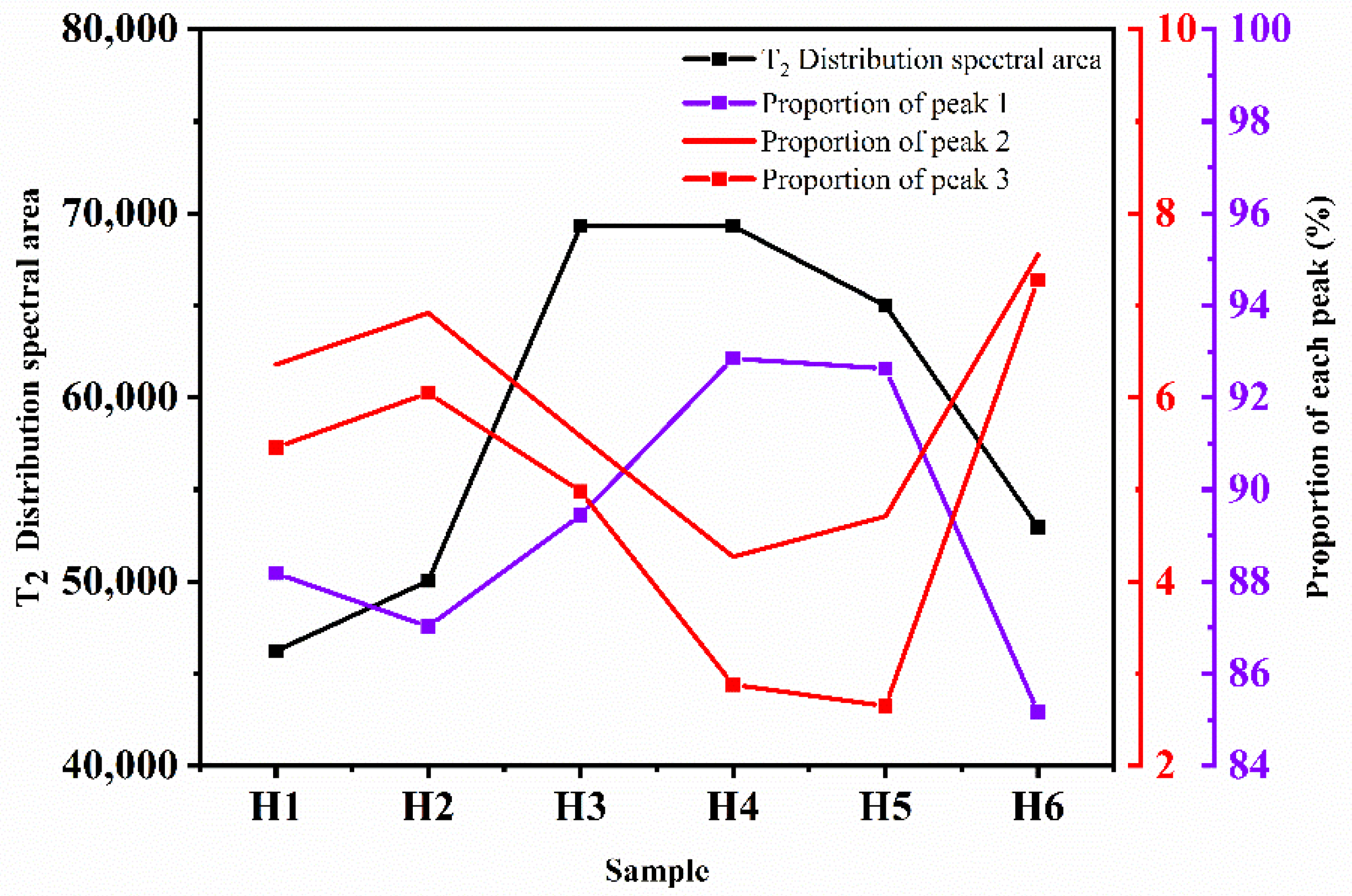
| Pipe Diameter /nm | Tube Length /µm | Purity /% | Ash /% | Specific Surface Area /m2·g−1 | Packing Density /g·cm−3 |
|---|---|---|---|---|---|
| 10–20 | 5–50 | >85 | <2.0 | 200–300 | 0.006–0.09 |
| Sample | Cement | Silica Fume | Fly Ash | Slag Powder | Sand | W/B | Water Reducer | MWCNTs Content (%) |
|---|---|---|---|---|---|---|---|---|
| M1 | 540 | 100 | 180 | 100 | 1080 | 0.16 | 2.5% | 0/0.02/0.05/0.10/0.15/0.20/0.30 |
| M2 | 540 | 100 | 180 | 100 | 1080 | 0.17 | 2.5% | 0/0.02/0.05/0.10/0.15/0.20/0.30 |
| M3 | 540 | 100 | 180 | 100 | 1080 | 0.18 | 2.5% | 0/0.02/0.05/0.10/0.15/0.20/0.30 |
| M4 | 540 | 100 | 180 | 100 | 1080 | 0.19 | 2.5% | 0/0.02/0.05/0.10/0.15/0.20/0.30 |
| M5 | 540 | 100 | 180 | 100 | 1080 | 0.20 | 2.5% | 0/0.02/0.05/0.10/0.15/0.20/0.30 |
| Sample | Erosion Solution Type | Type and Dosage of Salt /g·L−1 | Solution Mass Fraction/% | ||
|---|---|---|---|---|---|
| NaHCO3 | NaCl | Na2SO4 | |||
| F1 | Composite salt | 14.38 | 7.46 | 13.36 | 3.4 |
| F2 | Bicarbonate | 14.38 | 0 | 0 | 1.42 |
| F3 | Chloride salt | 0 | 7.46 | 0 | 0.74 |
| F4 | Sulphate | 0 | 0 | 13.36 | 1.32 |
| F5 | Clean water | 0 | 0 | 0 | 0 |
| Name | Model Parameters |
|---|---|
| Collector type constant temperature heating magnetic stirrer (Shanghai Yuhua Instrument Co., Ltd, Shanghai, China) | DF-101S |
| Ultrasonic cleaner (Shenzhen yuanpin Instrument Co., Ltd, Shenzhen, China) | KQ-250B |
| Single horizontal shaft forced concrete mixer (Wuxi Jianyi Instrument Machinery Co., Ltd, Wuxi, China) | HJW-60 |
| Microcomputer controlled electro-hydraulic pressure testing machine (Shanghai Linjia science and Education Instrument Co., Ltd, Shanghai, China) | TYW-2000 |
| Constant loading pressure testing machine (Wuxi xinluda Instrument Equipment Co., Ltd, Wuxi, China) | EHDC |
| Concrete freeze-thaw testing machine (Shanghai Sanhao refrigeration equipment factory, Shanghai, China) | CDR-5 |
| Dynamic elastic modulus tester (Tianjin Yaxing Automation Experimental Instrument Co., Ltd, Tianjin, China) | DT-20W |
| Electron scanning microscope (Shanghai Baihe Instrument Technology Co., Ltd, Shanghai, China) | JSM-IT100(L) |
| Nuclear magnetic resonance imaging analyzer (Suzhou niumag Analytical Instrument Co., Ltd, Suzhou, China) | MesoMR12-060H-I |
| Number | Author | Number of FT Cycles | Compressive Strength Loss Rate (%) | Mass Loss Rate (%) |
|---|---|---|---|---|
| 1 | Lu et al. [43] | 300 | 27.5 | −0.65 |
| 2 | Lee et al. [44] | 300 | −3 | - |
| 600 | 1 | - | ||
| 1000 | 6 | - | ||
| 3 | Ji et al. [45] | 500 | 4.9–17.8 | 0.57–0.95 |
| 4 | Li et al. [46] | 800 | 0.869–1.501 | - |
Publisher’s Note: MDPI stays neutral with regard to jurisdictional claims in published maps and institutional affiliations. |
© 2022 by the authors. Licensee MDPI, Basel, Switzerland. This article is an open access article distributed under the terms and conditions of the Creative Commons Attribution (CC BY) license (https://creativecommons.org/licenses/by/4.0/).
Share and Cite
Liu, G.; Zhang, H.; Liu, J.; Xu, S.; Chen, Z. Experimental Study on the Salt Freezing Durability of Multi-Walled Carbon Nanotube Ultra-High-Performance Concrete. Materials 2022, 15, 3188. https://doi.org/10.3390/ma15093188
Liu G, Zhang H, Liu J, Xu S, Chen Z. Experimental Study on the Salt Freezing Durability of Multi-Walled Carbon Nanotube Ultra-High-Performance Concrete. Materials. 2022; 15(9):3188. https://doi.org/10.3390/ma15093188
Chicago/Turabian StyleLiu, Guifeng, Huadi Zhang, Jianpeng Liu, Shuqi Xu, and Zhengfa Chen. 2022. "Experimental Study on the Salt Freezing Durability of Multi-Walled Carbon Nanotube Ultra-High-Performance Concrete" Materials 15, no. 9: 3188. https://doi.org/10.3390/ma15093188





